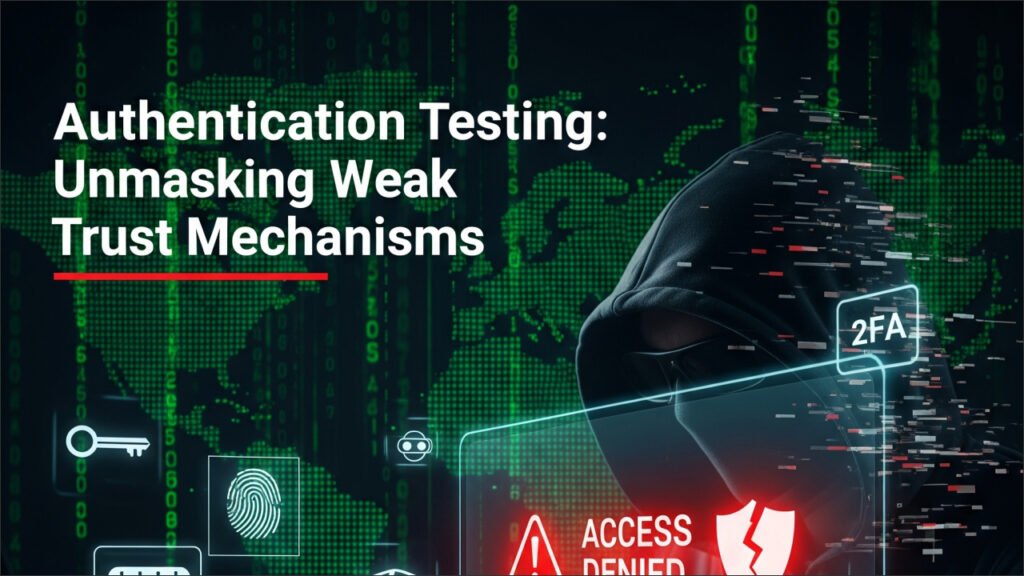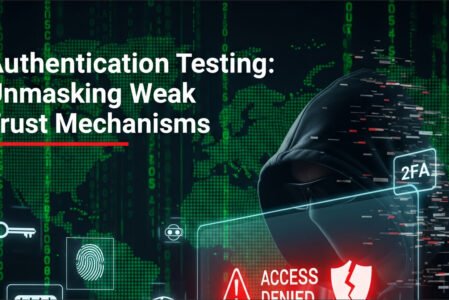Every login form hides a story—read it like a hacker, protect it like a guardian.
Authentication isn’t just a feature—it’s the digital lock that stands between an attacker and your data. When this lock is weak, predictable, or poorly maintained, it becomes the first and most attractive target for hackers. As ethical hackers and bug hunters, your job isn’t to break the system for chaos’s sake. It’s to think like those who would—before they do.
Welcome to the silent battlefield of authentication testing.
Table of Contents

Login Bruteforce (Safe Simulation): Testing the Lock’s Limits
Forget about hammering login endpoints with thousands of requests. Real ethical testing is quiet, deliberate, and calculated. Start with identifying if rate-limiting, account lockouts, CAPTCHA, or IP throttling exist. Try:
- Username enumeration via response differences.
- Delays or error timing to fingerprint rate-limiting.
- Safe-mode bruteforcing using small curated password lists (e.g., top 10 weak corporate passwords).
It’s a patient thief’s game, wondering, “How many tries before this gives way?” A controlled test with a small wordlist—maybe “password123,” “admin”—watches for lockouts or errors. If the system allows 100 tries without a cap, that’s a goldmine. Linking this with password strength analysis shows how weak creds amplify the risk.
A hacker doesn’t brute force blindly. It collects intel, adapts, and strikes efficiently.
Password Strength Analysis: Spotting the Weak Links
Authentication systems often allow users to set weak passwords. As an ethical hacker, this isn’t about guessing passwords but exposing poor enforcement policies:
- Test for minimum length, complexity, and reuse rules.
- Check how the system handles weak passwords like “Password123!” or common seasonal passwords.
- Use breached password lists for simulation (responsibly, of course).
Attackers exploit laziness—your job is to highlight it before they do.
Credential Stuffing Testers: Checking the Reused Keys
Credential stuffing isn’t just a buzzword. It’s a real-world threat born from reused passwords across systems. Ethical testing includes:
- Checking for bot mitigation like fingerprinting, WAFs, and anomaly detection.
- Observing for uniform error messages that don’t reveal valid credentials.
It’s a scavenger hunt for easy wins, thinking, “Who reused their Netflix login here?” Simulating attacks with known leaked creds watches for successful logins. If 10% work, that’s a jackpot. Linking this with session management testing shows if stolen sessions linger, turning a login flaw into a full account takeover scenario.
Session Management Testing: Keeping an Eye on the Keys
Once logged in, how the session is managed can make or break security. An ethical hacker thinks in session lifespan, renewal, and hijacking possibilities:
- Are session tokens invalidated on logout?
- Can a session be reused across devices?
- Is there inactivity timeout?
- Can the token be sniffed or intercepted (e.g., via insecure cookies or no HTTPOnly)?
It’s a shadow trailing a guard, asking, “Can this key be stolen and reused?” Grabbing a session cookie after login and trying it in another browser tests the setup. If it works without expiring, that’s a flaw. Linking this with token testing exposes weak session generation, showing how an attacker could hijack multiple users.
Token Testing (JWT, OAuth): Cracking the Digital Passports
Modern authentication has moved towards tokenization, especially JWTs and OAuth flows. But complexity breeds vulnerability. Test like this:
- Decode JWTs and analyze claims. Is the algorithm none? Is it using HS256 where RS256 should be?
- Test for token replay, tampering, or predictable expiration.
- Simulate OAuth misconfigurations (e.g., open redirects, weak client secrets).
It’s a forger at a checkpoint, wondering, “Can this passport be tweaked?” Decoding a JWT, swapping the “user” claim to “admin,” and testing if the server accepts it checks the setup. If it does, that’s a bypass. Linking this with session management flaws keeps the fake token alive, turning a single tweak into a persistent admin access exploit.
A hacker’s mindset isn’t satisfied with logging in. It tries to become another user, elevate privileges, or hijack the identity flow itself.
The Hacker’s Mindset: Why Chains Matter
Authentication bugs rarely stand alone. They are the entry point to a longer chain:
- Bruteforce leads to weak password reuse.
- Weak sessions lead to IDOR or CSRF.
- Insecure token handling leads to privilege escalation.
Conclusion: Your Job Isn’t to Guess Passwords. It’s to Think Like Those Who Do.
Authentication Testing is more than a skill—it’s a journey into a network’s defenses. For ethical hackers and bug hunters, it’s about outsmarting the system, safeguarding the digital world, and maybe scoring a sweet reward. By mastering brute-forcing, token checks, and session probes, and weaving them with a hacker’s gut, it’s not just testing—it’s telling a story of discovery.


